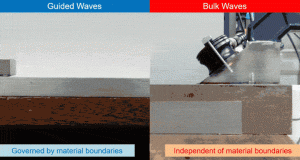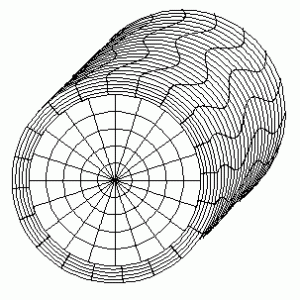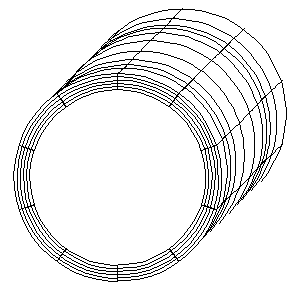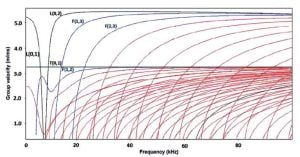Studios
-
Support
-
Contact us
-
Products
Studios
In ultrasound, there are two types of waves, namely the Guided Waves and Bulk Waves.The existence of these waves depends on the material geometry (shape, thickness) and the inspection frequency or wavelength. Therefore, at relatively low frequencies (~25 kHz), Guided Waves can exist in pipes (and other geometries) because the wavelength is relatively much larger than the wall thickness of the pipe. For example, guided wave signals at 25 kHz typically have a wavelength of 130 mm and pipe wall thicknesses are typically within the range of 3 to 40 mm (1/8 to 1.57 inch).

Torsional T(0,1) mode

Longitudinal L(0,2) mode

Different types or modes of guided waves can exist for different structures (e.g. pipes, plates, rails) since guided waves are dependent on the material geometry. In the context of pipe inspection, the two most common types of pipe guided waves modes for guided wave testing are the Torsional T(0,1) and Longitudinal L(0,2) modes. The fundamental Torsional and Longitudinal waves are analogous to the Shear and Compressional waves in Ultrasonic Thickness (UT) testing respectively.
Although these modes are roughly analogous to the UT waves and the terms ‘Guided Wave UT’ or LRUT is often used to describe the technology, the interaction with defects is often very different and specialist guided wave knowledge is needed to configure the system.
The Guided Waves can propagate along the pipe at velocities that can be determined from Dispersion Curves. The Dispersion curve is a graph of phase or group velocity against the signal frequency (or the product of frequency and thickness). This plot shows how the velocities of the guided wave vary according to the mode and frequency.
Our years of experience have been incorporated into the WavePro software, so that inspector does not need to understand the physics in this plot, but is able to concentrate on evaluating the integrity of the asset.

The plot above is the group velocity dispersion curves for an 8″ schedule 40 steel pipe generated using DISPERSE. The fundamental longitudinal L(0,1), torsional T(0,1) and flexural F(1,2), F(1,3) and F(2,3) wave modes have been labelled.